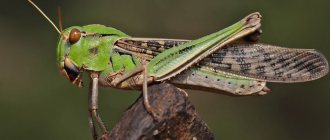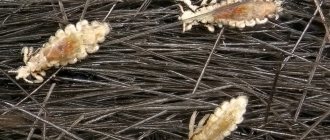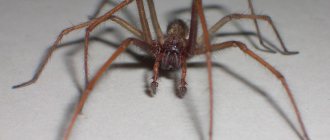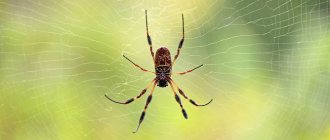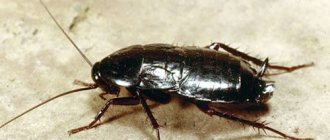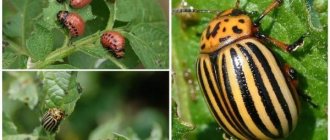What does a ladybug look like?
The ladybug looks quite small.
The size of the ladybug reaches a length of 4 to 9 mm. The ladybug looks recognizable, because most often it is colored red and strewn with black dots. The ladybug has a convex, almost round body. The ladybug looks interesting, because there are so many small details in the structure of its body. The ladybug insect has a head, pronotum, chest, abdomen, wings with elytra and paws. The ladybug has a small and short head, which is motionlessly connected to the pronotum. On the head of the insect there are eyes and movable antennae. The ladybug beetle flies using a pair of hind wings.
Everyone knows that the ladybug looks so bright to scare away predators. In addition to the variegated colors, the ladybug also secretes a yellow liquid with a sharp, specific odor. This liquid is poisonous and serves as protection against frogs, spiders and other potential enemies. The ladybug beetle secretes its poisonous liquid from the joints of its legs in case of danger. Also, when in danger, an insect can even pretend to be dead.
Of course, the red ladybug is not the only color option for this insect. There is a yellow ladybug, a black ladybug and even a white ladybug. What a ladybug looks like and what color it will be depends on the type of ladybug. At the same time, young individuals have the most saturated color; in older individuals, it fades over time.
How to fight bedbugs with soldier soldiers
Fighting different insects has different methods and means. Before you begin to destroy the insect, you need to make sure that it is the wingless soldier beetle that is spoiling the plants. To do this, it is not necessary to inspect all the plants . There are the following signs of high insect activity:
- buds and flowers on cultivated plants in beds and flower beds wither and fall off very quickly, much earlier than expected;
- Specific yellow spots appear on the leaves of white cabbage;
- dill, coriander and other plants of this type begin to quickly turn yellow, wither and crumble;
- carrots and beets grow rather slowly, even with sufficient watering and light solar activity, young shoots quickly curl and wither.
combat the activity of black beetles with red spots in the following ways throughout the year:
- If clutches of eggs are found on plants, they must be very quickly destroyed, or rather, burned. Also, in early winter or autumn, it is necessary to dispose of old rotten trees, stumps, and dried grass by burning.
- Before planting cultivated plants, it is necessary to completely clear the area of plants such as wormwood, quinoa and legume sprouts.
- If black bugs entered the site and began to “spoil” cultivated plants, grapes and flowers, any legume plant, including alfalfa, can be planted near the planting sites. The soldier bug loves the juice of this particular plant most of all, so he will happily leave the rest. In autumn, in order to destroy the population, the plants are carefully mowed down and burned.
- In case of a large number of insects, a folk remedy can be used to destroy them. To do this, you need to boil the onion peel, cool it to room temperature and spray the affected plants. Solutions of ash, mustard and laundry soap are used in the same way.
- If there are few insects, but they constantly appear on the site, you can plant a cynicifugu plant in the spring. This plant has a specific smell that repels any bugs and they leave the area.
There is also a wide range of different chemicals available.
They can be sprayed on a plant, which will cause the death of insects. But experts recommend not using this method so as not to damage the fruits and young shoots. Many people try to collect bugs from plants and destroy them separately.
See
- Yellow – brings happiness, portends favorable changes.
- With white spots - good news.
- Black with red dots - brings success in business.
- A lot of bright red insects on the street predict a friendly and large family for the person who sees it. For landowners, this is a happy omen, meaning a rich harvest of rye.
- Without spots - the ladybug itself has just been born and portends the birth of a baby.
- With two points - a person will learn to be reasonable and begin to make the right decisions.
DETAILS: A red dot appeared on the face, how to get rid of small formations
In ancient times, the number of spots on the back of an insect was used to determine how many lucky months there would be in a year. The happiest cow is the one with 7 black dots on its body. In this case, you need to release the insect into the wild with the words: “The number of spots on the cow’s body, the number of happy months there will be this year.”
Habitats
Beetles, popularly called soldier beetles, are most often encountered on the street or in the garden. They nest in old rotten wooden logs, tree trunks or plank fences. Sometimes such surfaces are literally strewn with colonies of soldiers.
But in these places, insects just rest, but to obtain nutrients they go hunting, depositing young growth in the garden and causing irreparable damage to the crop in the garden. Gardeners often find soldiers in cabbage , carrot or beet tops, on the leaves of garden trees or currant bushes. In any case, if the owner of the site discovers colonies of soldier beetles nearby, he should immediately think about how to drive them away.
Despite its outwardly harmless appearance, the bug causes serious damage to garden crops. The insect lays eggs directly in plants (on leaves or stems), while simultaneously sucking out all the juice from them. They are especially dangerous for elite grape varieties. Due to the fact that they feed on the juice of garden crops, they are classified as serious pests. The gardener must understand that it is not so much the adult soldier bugs that cause harm, but rather their eggs and larvae. And for this reason, their appearance in the garden area should be prevented in a timely manner. Often these garden pests cause damage to young shoots of beets, carrots, dill and other garden vegetation. Plants that have not yet become strong and have not gained vitality simply die from the influence of soldiers.
What does the soldier bug eat?
In order to effectively combat garden pests, it is necessary to understand what these insects eat and where do they live?
The red beetle with black spots, popularly known as the soldier bug, is completely unpretentious in food. Few people know what soldier beetles eat, but this information is very important, especially for gardeners who can suffer significant losses from black-and-red pests.
So, in order to exist fully, the red-black beetle only needs plant sap. He obtains it by piercing leaves or stems with a sharp proboscis. After such an impact, the cultivated vegetation stops bearing fruit and gradually dies off. If soldier beetles damage vegetable, fruit or berry fruits, then they cease to be suitable for consumption. If there is no fresh sap nearby, then black-and-red bugs can even eat carrion. Bed bugs gather in colonies on dead insects, and sometimes they can even be seen on the corpses of vertebrate animals. Oviposition is done by this insect directly on the leaves, cuttings and stems of plants. This prevents the risk of food shortages for the young. Young red larvae will always find something to eat, thanks to this placement of oviposition. Gathering in large colonies, they cause irreparable damage to many garden and vegetable crops:
How does a ladybug live?
The ladybug lives almost everywhere except the Arctic and Antarctic. Ladybug lives on trees, bushes and grass in different parts of the world. Most often, the ladybug lives in the steppe zone, forests, mountains and gardens. In Russia, the ladybug lives almost throughout the entire territory, with the exception of the extreme northern regions. The ladybug also lives in Europe, Asia, Japan, China, India, Mongolia, Africa, Korea and America.
The ladybug lives, being active from early spring until late autumn. In winter, ladybugs hide under fallen leaves, tree bark or stones, where they remain until spring. But not all ladybugs live sedentary lives and remain to spend the winter where they spent the summer. Often, before the onset of cold weather, ladybugs migrate.
During wintering and migration periods, ladybugs, which usually lead a solitary lifestyle, gather together. Mass accumulations of this beetle are also typical during the mating season. In spring, the ladybug wakes up very early; for her, it is enough for the temperature to reach only 10 °C. Therefore, the ladybug can be one of the first to be seen after winter. Ladybugs live from 10 to 12 months and only occasionally up to 2 years. The lifespan of a ladybug depends on the availability of food.
Where is it distributed?
The soldier bug is widespread throughout Eurasia, northern Africa and the United States. Countries with a temperate climate are favorable for insect reproduction.
Bedbug habitat:
- under the bark of trees;
- on stumps;
- in piles of dry grass and leaves;
- at the foundations of houses, baths, gazebos and other outbuildings;
- in the fence and its foundation.
During hibernation, insects are found under heaps of garbage, in humus, in trees - under the bark or in hollows.
Sela
- On the hand: on the right - to the fulfillment of a cherished desire; to the left - to improved health. Also, a ladybug on your hand is a good reason to tell fortunes for the future. You need to ask the bug a question and gently blow under its wings: if the beetle flies up, your plan will come true, but if it continues to wander around your hand, the hope will not come true or will be fulfilled with a delay. When the bug lands on your hand, you need to count to 22; if it does not fly away before the end of the count, then happy love awaits the person.
- On the head is a lucky sign for work. Your career will take rapid strides, your authority will increase, if there is any unpleasant situation, it will quickly be resolved for the better. It is important not to get scared and not to brush the insect off your head onto the ground, otherwise the luck and success that it brought will bypass you.
- On the face - promises happy love.
- On the hair - to money, promotion, respect and honor. If a ladybug gets tangled in the curls, then a person will experience a rapid transition to a new, joyful and prosperous level of life.
- On the shoulder is a neutral sign. Nothing significant will happen, but your mood and well-being will improve, and happy events in life will increase.
- On your back - a difficult situation will quickly be resolved.
- On the chest - to a happy life.
- On the leg - happiness will come, but a little later.
- For clothes - to pleasant surprises from a loved one.
DETAILS: Nizoral shampoo - Analogues, Prices and Reviews
If you flew into the house
The appearance of a little traveler in a home brings only good news. This can be learned from the following signs:
- If you fly into a house where a married couple lives, dreaming of having children, then good news awaits them soon.
- If it appears where a family lives, in which quarrels and misunderstandings often occur, then after some time the situation in the family should improve. The presence of a ladybug on the family bed means that scandals will cease to occur between husband and wife, and there will be more understanding and good attitude towards each other.
- The appearance of a bug in a girl’s room is a sign of imminent marriage or a new romantic relationship.
- A ladybug appeared in a home in the spring and summer season - to monetary profit, in the autumn - to an increase in the family, in the winter - to grandiose and happy changes in life.
Ladybug larva
The mating season for ladybugs occurs in mid-spring, when the insects have already gained strength after hibernation or migration. During the breeding season, the female secretes a special secret through which the male finds her. After which the female lays eggs on the plants. The ladybug chooses a place closer to aphid colonies so that the offspring are provided with food.
Ladybug eggs look like pointed, oval-shaped grains and can be yellow, orange or white. The female deposits them on the underside of the leaves or stems of the plant. One ladybug can lay up to 400 eggs, placing them in small piles. If the female feeds well, she can lay up to 1 thousand eggs.
After about a couple of weeks, variegated oval-shaped ladybug larvae with a bluish-gray tint appear from the laid eggs. The ladybug larva has thin bristles on its body and a peculiar pattern, which is formed by a combination of orange, yellow and white spots. After hatching, the ladybug larva eats the shell of its egg and the dead eggs. When the larva gets stronger, it begins to destroy aphid colonies. The voracious ladybug larvae eats up to 300 aphids per day.
The ladybug will remain in the larval stage for about 4-7 weeks. All this time, the ladybug larva is very mobile, because it is in constant search of food. The ladybug larva then develops into a pupa and attaches itself to the plant. As it develops, it begins to acquire all the characteristic features of a full-fledged insect. After about 10 days, a fully formed adult individual emerges from the cocoon.
What harm do insects and their larvae cause?
Some time ago, the soldier bug was not considered a harmful insect at all: it crawled and crawled on its own, without bothering anyone. But science, studying an increasing number of plants, insects and animals, got to him and delivered a verdict - guilty!
In addition to the fact that soldiers, like aphids, eat sap and are scavengers, their aggression towards beneficial insects, for example, lacewings, has recently become noticed.
With soldiers, everything ends up the same as with aphids, the leaves become bent, the shoots stop growing. Photosynthesis decreases, the plant’s consumption of nutrients is reduced, hence the reduction in yield. It often happens that plants attacked by hordes of beetles simply die. And fruits and berries, speckled with bites from such insects, look, to say the least, not at all attractive.
Grape plantings are at particular risk, and, by the way, these bugs are seen there most often. The strength and durability of the soldiers' proboscis is quite enough to pierce the grape stems and the fruits themselves, turning them into something wrinkled and completely unattractive. You need to constantly fight soldier bugs, and now we will tell you how.
Origin of the species and description
Photo: Fireman Beetle
The fireman beetle is a medium-sized insect that got its name because of its original appearance, which includes red elements in its color. Quite often, this animal is confused with other beetles, called soldier bugs, onion rattles and bee moths by firemen. However, these are all completely different insects, with their own habits and external features.
Video: Fireman Beetle
Biologists also call firefighter beetles red-legged soft beetles. This is due to the bright burgundy color of the beetle’s legs and the absence of chitinous cover. The elytra of insects are very flexible and soft. Therefore, people believe that firefighters, like other representatives of soft-bodied animals, are more likely than others to be attacked by other animals and predators. But that's not true! These bugs can take care of themselves.
The fireman beetle is an insect of the soft-bodied family, order Coleoptera. It is quite easy to recognize this creature. His head is decorated with small antennae, very thin, resembling threads. These antennae are constantly in motion. There is a dark spot at the top of the head. It is by this that one can distinguish the fireman's beetle from other beetles. The body is rectangular, elongated. Adults rarely grow more than 1.5 centimeters in length. The belly is painted a bright burgundy color.
Firefighter beetles are usually found in gardens and are beneficial to humans. They effectively exterminate a huge number of insect pests. However, sometimes the population of such beetles grows very large and it becomes necessary to exterminate them. Firefighter beetles do not have to be poisoned, thereby polluting your own garden. Such insects can simply be collected by hand. But this method is relevant if the beetles have not yet had time to multiply very much. Otherwise, you can flavor the plants with a mixture of cheap tobacco and wood ash.

